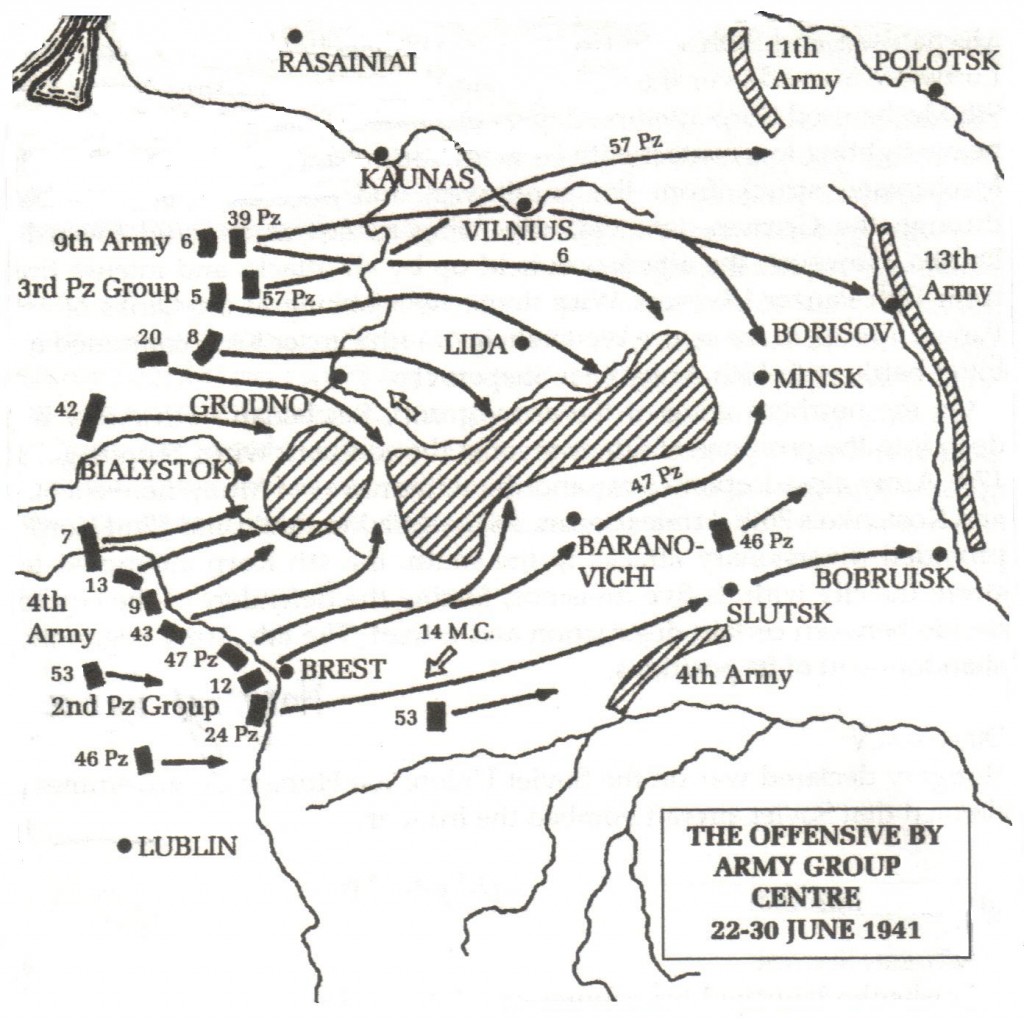In the central sector, north of the Pripet Marshes (the most vital sector as far as the German plan was concerned), things went really wrong for the Soviets. This was primarily because it was where the main effort of the German offensive occurred, and it was against the second strongest (not the strongest) Military District in the USSR. Pavlov’s Western Special Military District (Western Front from 22nd June) faced two German Panzer Groups as opposed to only one in the other sectors. These were the 3rd Panzer Group (Hoth) with two panzer corps and four panzer divisions, and 2nd Panzer Group (Guderian) with three panzer corps and five panzer divisions. In terms of overall equipment and support units, 2nd Panzer Group was the most powerful panzer group in the Wehrmacht in June 1941.
The 3rd Panzer Group launched its offensive north of the Bialystok salient and had already reached the Nieman River by midday on the 23rd June. Despite several localised counter-attacks, by 24th June leading elements of 57th Panzer Corps (Kuntzen) had reached Vilnius while 39th Panzer Corps (Schmidt) advanced rapidly towards Minsk. Meanwhile 9th Army (Strauss) followed in support and placed immense pressure on the Soviet 3rd and 10th Armies around Bialystok, Grodno and then Lida. By 26th June 39th Panzer Corps was only 18 miles north of Minsk while other elements of the corps headed for Borisov in order to jump the Beresina River. Meanwhile the 57th Panzer Corps headed towards Polotsk on the upper Dvina River.

Maps, Copyright; Brian Taylor 2003, Barbarossa to Berlin.
The 2nd Panzer Group punched a hole through the 4th Army defences on the Bug River, bypassed the fortress of Brest-Litovsk (which held until 29th June), made short work of the 14th Mechanised Corps (4th Army’s armoured reserve which was destroyed as an offensive force in two days) and rapidly proceeded north-eastwards. The 24th Panzer Corps crossed the Bug south of Brest and headed straight for Slutsk and Bobruisk on the Beresina River. Slutsk fell on 26th June and Bobruisk was reached on 28th-29th June. By 30th June the 24th Panzer Corps had secured a crossing of the Beresina River and despite repeated counter-attacks on the bridgehead (and attempts by the VVS to bomb the bridges) the 24th Panzer Corps was soon across.
The 47th Panzer Corps crossed the Bug north of Brest, proceeded through Slonim (captured after a fierce fight) and headed towards Baronovichi which was captured on 25th June. The corps then wheeled north-east towards Minsk where it linked up with 3rd Panzer Group’s 39th Panzer Corps on 27th June. The resultant Bialystok-Minsk pocket contained the Soviet 3rd and 10th Armies, and most of 4th and 13th Armies: almost the entire Western Front and its reserves that existed on 22nd June 1941.
Close behind the 2nd Panzer Group’s main thrusts followed 46th Panzer Corps (Vietinghoff) and 4th Army (Kluge). 4th Army attacked north and north-eastwards and on 28th June its infantry linked up with 9th Army west of Bialystok. Thus the Bialystok-Minsk pocket was actually sliced into two major pockets; one centred around Bialystok and the other a much larger pocket east of Minsk. It took until 8th July for these pocket to be liquidated by the German 4th and 9th Armies, yielding approximately 288 000 POWs.
Western Front’s commander, Army General D.G. Pavlov (who was summarily executed for treason) was used, along with several other senior officers, as a scapegoat for Western Front’s rapid collapse. Unfortunately much post-war literature has continued with the idea that Western Front’s command failed in some exceptional way. In fact an in depth analysis of the state of the respective forces involved (especially the Soviet unit’s totally inadequate transport), the German Army’s operational technique and tactical combat proficiency, the speed with which the panzer corps’ could advance, and the unfavourable initial deployment of Soviet forces (which was largely due to the Stavka’s direct involvement), shows that Western Front never really had a chance. Even if Pavlov had immediately known the seriousness of the situation and issued appropriate orders (with his already crippled command and communication systems) it would have been very difficult to save the bulk of Western Front. Pavlov may not have been a brilliant commander but he was no worse than most of his generation. He was largely a victim of being in the wrong place at the wrong time; along with most of the other 671 000 Red Army soldiers in the Western Special Military District on 22nd June 1941.
